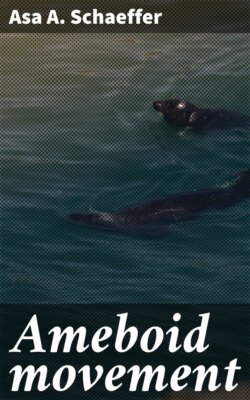Ameboid movement

Реклама. ООО «ЛитРес», ИНН: 7719571260.
Оглавление
Asa A. Schaeffer. Ameboid movement
Ameboid movement
Table of Contents
PREFACE
CHAPTER I. Introduction
CHAPTER II. Historical Sketch
CHAPTER III. The General Features of Endoplasmic Streaming
CHAPTER IV. The Transformation of Endoplasm into Ectoplasm
CHAPTER V. Pseudopods and the Nature of the Ectoplasm
CHAPTER VI. The Species Question
CHAPTER VII. Experiments on the Surface Layer of the Ameba
CHAPTER VIII. ON THE NATURE OF THE SURFACE LAYER
CHAPTER IX. The Surface Layer and Theories of Ameboid Movement
CHAPTER X. Streaming, Contractility and Ameboid Movement
CHAPTER XI. The Surface Layer as a Locomotor Organ
CHAPTER XII. The Wavy Path of the Ameba
CHAPTER XIII. The Wavy Path of the Ameba and the Spiral Paths of Ciliates and other Organisms
CHAPTER XIV. Conclusions
BIBLIOGRAPHY
Отрывок из книги
Asa A. Schaeffer
Published by Good Press, 2019
.....
It often happens, such as when the ameba is receiving a strong stimulus, that streaming is arrested and brought to a stop for a few seconds, more or less. Presently however the endoplasm begins to flow as before. At what point, in such a case, is the first movement of endoplasm detectible? Is it at the free end of the pseudopod, at its middle region, at its base, or at the posterior end of the ameba? Bütschli (’80, p. 116) observed that in a withdrawing pseudopod the streaming begins at the free end of the pseudopod; but his (’92, p. 201) later explanation of ameboid movement seems to require that the endoplasm must begin to move at the base of the withdrawing pseudopod. Jennings (’04, p. 157) observed that in a withdrawing pseudopod the current of endoplasm begins at the base of the pseudopod.
From numerous observations directed toward this point, it appears that the conditions under which streaming is resumed after a pause, whether in the same or in the reverse direction, are of great variety. The shape, size, slenderness, and the position on the ameba of the pseudopod, as well as the strength and character of the stimulus, are among the factors capable of changing in whole or in part the flow of endoplasm in a pseudopod. In an ameba that has been moving along a homogeneous flat surface, as nearly unstimulated as may be, the endoplasm first begins to flow out of the lower half of the retracting pseudopod, if the pseudopod is more or less uniformly conical in shape and rather slender. In such a case it may be said that the retracting pseudopod was withdrawn “by the ameba,” and that it did not itself receive an external stimulus producing retraction. If, however, the tip of a pseudopod as described receives a strong negative stimulus, the endoplasm frequently flows back from the tip while it is still flowing into the pseudopod at the base. But very soon thereafter, in such an event, the streaming becomes unified and the pseudopod is withdrawn. In broad pseudopods about to be withdrawn, the endoplasm may begin to move anywhere along its length. This is undoubtedly due to the continuous local changes in the walls of the pseudopod, which are characteristic of this species of ameba (see p. 20).
.....